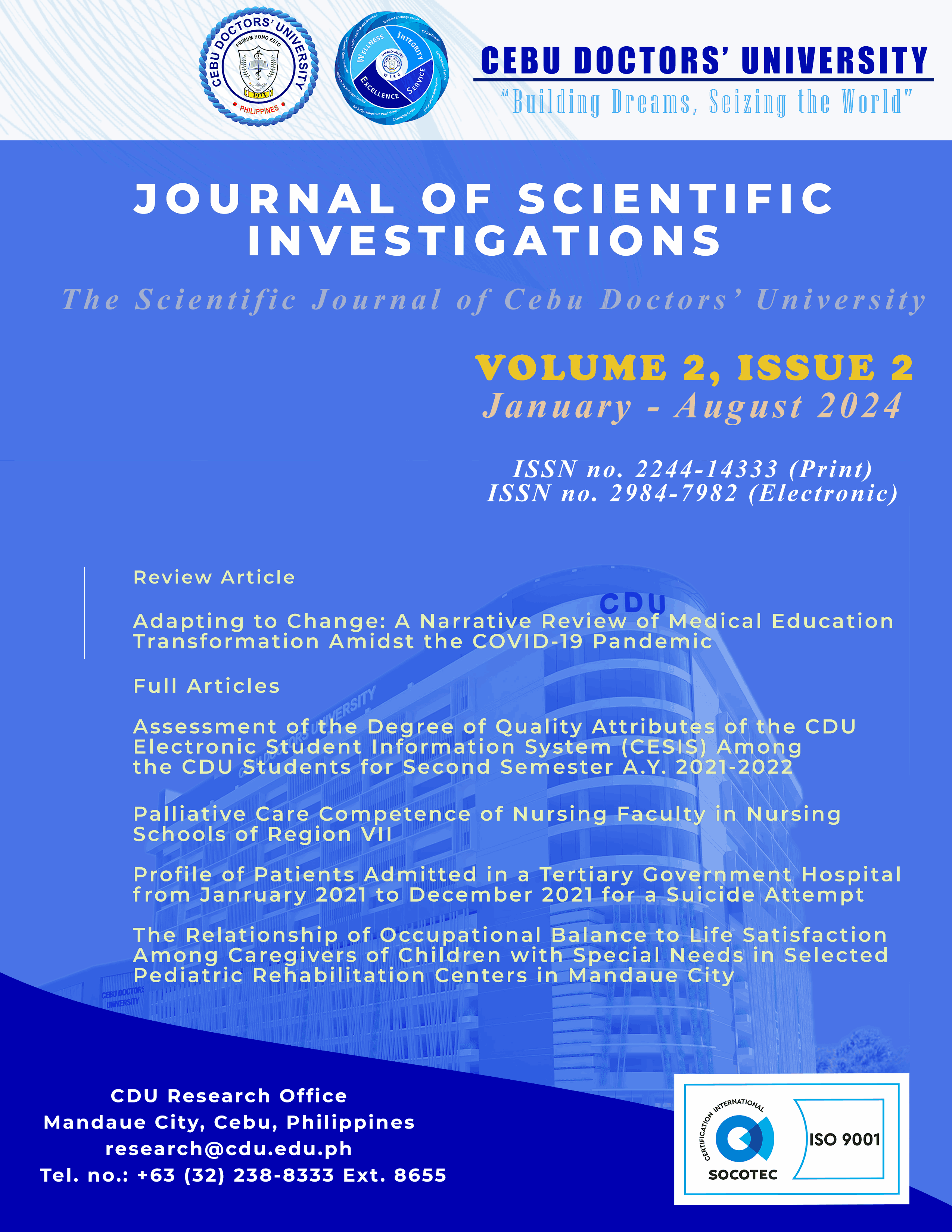The Relationship of Occupational Balance to Life Satisfaction Among Caregivers of Children with Special Needs in Selected Pediatric Rehabilitation Centers in Mandaue City
Keywords:
caregivers, children with special needs, life satisfaction, occupational balanceAbstract
This study investigated the relationship between the level of occupational balance and life satisfaction level among caregivers of children with special needs in selected pediatric rehabilitation centers in Mandaue City in the year 2021. A total of eighty-one (81) caregivers participated in the study. Two (2) questionnaires were utilized, namely the “Occupational Balance Questionnaire” developed by Håkansson and Wagman (2019) and the “Satisfaction With Life Scale” by Diener et al. (1985). Results showed that the majority of caregivers had a low occupational balance (49, 60.5%) and the minority achieved a high occupational balance (32, 39.5%). Results on “Life satisfaction” levels revealed the highest response for “slightly satisfied” (30, 37.0%). The findings also showed a moderate positive relationship between the level of occupational balance and life satisfaction level (rs=.412). This means that when the level of occupational balance increases, the life satisfaction level also increases. Similarly, as occupational balance decreases, life satisfaction also decreases.
References
Alias, N. A., Ghafar, I. H., & Azizan, A. (2019). Stress Coping Mechanism of Children with Learning Disabilities and Effects on Life Satisfaction of Caregivers. Environment-Behaviour Proceedings Journal, 4(12), 11-16. https://doi.org/10.21834/e-bpj.v4i12.1912
Aktan, O., Orakcı, E., & Durnalı, M. (2020). Investigation of the relationship between burnout, life satisfaction and quality of life in parents of children with disabilities. European Journal of Special Needs Education, 35(5), 679–695. https://doi.org/10.1080/08856257.2020.1748429
Arango-Lasprilla, J. C., Plaza, S. L. O., Drew, A., Romero, J. R., Pizarro, J. L., Francis, K. B., & Kreutzer, J. S. (2010). Family needs and psychosocial functioning of caregivers of individuals with spinal cord injury from Colombia, South America. NeuroRehabilitation, 27(1), 83–93. https://doi.org/10.3233/nre-2010-0583
Backman, C. L. (2004). Occupational Balance: Exploring the Relationships among Daily Occupations and Their Influence on Well-Being. Canadian Journal of Occupational Therapy, 71(4), 202–209. https://doi.org/10.1177/000841740407100404
Borgh, M., Eek, F., Wagman, P., & Håkansson, C. (2017). Organizational factors and occupational balance in working parents in Sweden. Scandinavian Journal of Public Health, 46(3), 409–416. https://doi.org/10.1177/1403494817713650
Çattık, M., & Aksoy, V. (2018). An Examination of the Relations among Social Support, Self-Efficacy, and Life Satisfaction in Parents of Children with Developmental Disabilities. TED EĞİTİM VE BİLİM. https://doi.org/10.15390/eb.2018.7246
Engelen, A. M. (2017, November 22). Occupational balance of mothers and fathers raising a child with special needs in Flanders. Stellenbosch University. Retrieved May 10, 2022, from https://scholar.sun.ac.za/handle/10019.1/102839
Gebeyehu, F., Sahile, A., & Ayalew, M. (2019). Burden, Social Support, and Life Satisfaction Among Caregivers of Children With Intellectual Disability: The Case of Felege Abay and Shembt Primary Schools, Bahir Dar, Ethiopia. International Quarterly of Community Health Education, 39(3), 147–153. https://doi.org/10.1177/0272684x18819974
Hanson, C., & Jones, D. (2002). Restoring competence in leisure pursuits. In C.A. Trombly & M.V. Radomski (Eds.), Occupational therapy for physical dysfunction (5th ed., pp. 745- 759). Philadelphia: Lippincott, Williams & Williams.
Diener, E., Emmons, R. A., Larsen, R. J., & Griffin, S. (1985). The Satisfaction With Life Scale. Journal of Personality Assessment, 49(1), 71–75. https://doi.org/10.1207/s15327752jpa4901_13
Kielhofner, G. (2008). Model of human occupation: Theory and application. Baltimore, MD: Lippincott Williams & Wilkins.
Knerl, L., & Long, J. N. (2020). The impact of caregiver role strain on family functioning. Journal of Family and Social Work, 24(1), 73-85. doi:10.1080/10522150.2019.1674313
Larson, E. A. (2000). The Orchestration of Occupation: The Dance of Mothers. The American Journal of Occupational Therapy, 54(3), 269–280. https://doi.org/10.5014/ajot.54.3.269
Larson, E. (2010). Identifying indicators of well‐being for caregivers of children with disabilities. Occupational Therapy International, 17(1), 29-39. https://doi.org/10.1002/oti.284
Law, M., Cooper, B. A., Strong, S., Stewart, D., Rigby, P., & Letts, L. (1996). The person-environment-occupation model: A transactive approach to occupational performance. Canadian Journal of Occupational Therapy, 63, 9-23. https://doi.org/10.1177/000841749606300103
Lu, M., Yang, G., Skora, E., Wang, G., Cai, Y., Sun, Q., & Li, W. (2015). Self-esteem, social support, and life satisfaction in Chinese parents of children with autism spectrum disorder. Research in Autism Spectrum Disorders, 17, 70–77. https://doi.org/10.1016/j.rasd.2015.05.003
Makundu, G. N., & Lo, R. C. (2013). A Path Analysis of Inspiration, Purpose in Life, Gratitude and Subjective Well-Being among Filipino Workforce. Educational Measurement and Evaluation Review, 4(1), 1-1. https://www.academia.edu/84899103/A_Path_Analysis_of_Inspiration_Purpose_in_Life_Gratitude_and_Subjective_Well_Being_among_Filipino_Workforce
Montgomery, R. J. V., & Kosloski, K. D. (2013). Pathways to a caregiver identity and implications for support services. In R. C. Talley & R. J. V. Montgomery (Eds.), Caregiving: Research, practice, policy. Caregiving across the lifespan: Research, practice, policy (p. 131–156). Springer Science + Business Media. https://doi.org/10.1007/978-1-4614-5553-0_8
Murphy, N. A., Christian, B., Caplin, D. A., & Young, P. C. (2007). The health of caregivers for children with disabilities: caregiver perspectives. Child: Care, Health and Development, 33(2), 180–187. https://doi.org/10.1111/j.1365-2214.2006.00644.x.
Schultz, S. M., & Schkade, J. K. (1992). Occupational Adaptation: Toward a Holistic Approach for Contemporary Practice, Part 1. American Journal of Occupational Therapy, 46(9), 829–837. https://doi.org/10.5014/ajot.46.9.829
Schultz, S., & Jk, S. (1992). Occupational Adaptation: Toward a Holistic Approach for Contemporary Practice, Part 2. American Journal of Occupational Therapy, 46(10), 917–925. https://doi.org/10.5014/ajot.46.10.917
Wagman, P., & Håkansson, C. (2014). Introducing the Occupational Balance Questionnaire (OBQ). Scandinavian Journal of Occupational Therapy, 21(3), 227–231. https://doi.org/10.3109/11038128.2014.900571
Yazdani, F. (2017). Introduction to the Model of Occupational Wholeness. Ergoscience, 12(1). https://doi.org/10.2443/skv-s-2017-5402017010
Downloads
Published
How to Cite
Issue
Section
License
Copyright (c) 2024 Erika May Guquib, Ma. Gilliane C. Piczon, Katreena A. Villarente, Shanielle Marie T. Villa, Mary Anne G. Delas Peñas

This work is licensed under a Creative Commons Attribution-NonCommercial 4.0 International License.
Authors retain copyright and grant the journal right of first publication with the work simultaneously licensed under a Creative Commons Attribution-Non-Commercial 4.0 International License that allows others to share the work with an acknowledgment of the work's authorship and initial publication in this journal. Readers can freely access and download the PDF, but for non-commercial purposes only and should not be used for monetary purposes.




